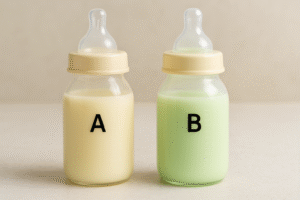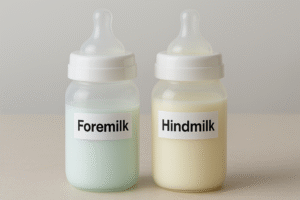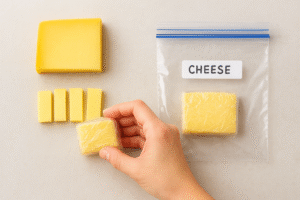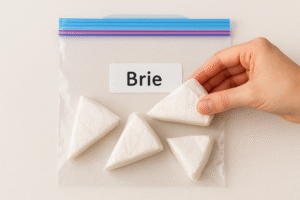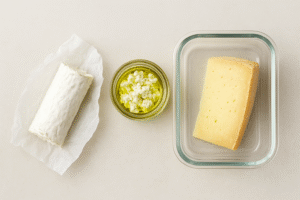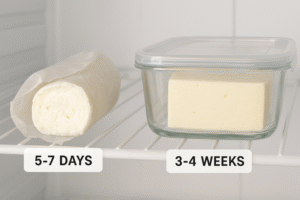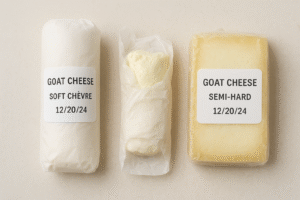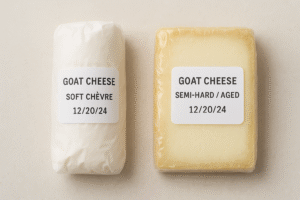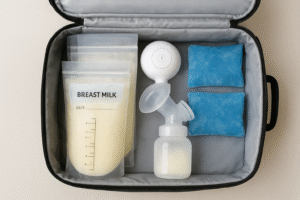Why Frozen Breast Milk Can Sometimes Go Bad
Freezing breast milk is one of the best ways to build a feeding stash — but even frozen milk isn’t immune to spoilage.
Many U.S. moms assume that once milk is frozen, it stays safe forever. Unfortunately, that’s not true.
Over time, frozen milk can lose nutrients, develop a soapy or metallic smell from lipase enzyme activity, or even experience freezer burn if not sealed properly.
This guide explains how to recognize when frozen breast milk has gone bad, how long it truly lasts in the freezer, and how to prevent waste while keeping your baby safe.
If you’re not sure about the right freezing method, check our guide on how to freeze breast milk flat for better storage.
🧠 Why Frozen Milk Can Spoil
Even under ideal conditions, breast milk isn’t meant to last forever.
Here are the most common reasons frozen milk can go bad:
- Lipase breakdown: Natural lipase enzymes break down fat molecules, causing a rancid or soapy taste.
- Freezer burn: Air exposure or poor sealing allows ice crystals to form, damaging flavor and nutrition.
- Temperature fluctuation: Opening and closing the freezer often can reduce stability.
- Storage time: Milk kept beyond 6–12 months loses both taste and vitamin potency.
👉 According to the Centers for Disease Control and Prevention (CDC), breast milk should ideally be used within 6 months for best quality — and a maximum of 12 months only if the freezer maintains a steady 0°F (–18°C).
🧩 Step-by-Step: How to Check If Frozen Breast Milk Is Still Safe
- Look for color changes: Normal milk may separate into layers, but grayish, yellow-green, or chalky textures are warning signs.
- Smell it after thawing: If it smells sour, metallic, or fishy even after gentle mixing, it’s likely spoiled.
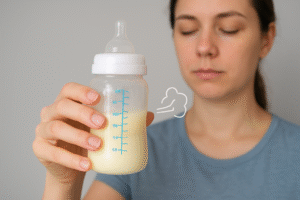
- Check for separation quality: Some natural fat separation is completely normal, but if the watery portion looks unusually clear or the thicker layer becomes grainy and clumpy, it could mean the milk has been frozen for too long and lost some of its nutritional quality. This small observation helps moms who may not notice smell or color differences but can detect texture changes.
- Taste test (optional): Safe milk tastes mildly sweet; spoiled milk is bitter or soapy.
- Check for freezer burn: White frosty spots or cracked edges inside the bag mean it’s unsafe.
- Check labeling: Discard any milk older than 6 months (or 12 if stored in a deep freezer).
For detailed thawing instructions, you can read our related guide on how to thaw out frozen breast milk safely.
🧺 Preventing Spoilage Before It Starts
To avoid losing precious milk, follow these U.S. mom-tested prevention tips:
- Use double protection: Store milk in quality freezer bags, then place those inside a solid container.
- Label clearly: Always note the date and time. First in, first out (FIFO) is the safest rule.
- Avoid frequent thaw-refreeze cycles: Once thawed, never refreeze.
- Freeze flat: This reduces air exposure and speeds up freezing, keeping milk nutrients intact.
- Keep milk away from freezer door: The temperature there fluctuates most.
These methods align with CDC’s Breast Milk Storage Guidelines and La Leche League International recommendations for safe freezing practices.
❄️ How Long Does Frozen Milk Really Last?

- Regular freezer: Up to 6 months (best quality within 3–4 months).
- Deep freezer: Up to 12 months if temperature stays at or below 0°F (–18°C).
- Freezer inside mini-fridge: Only 2 weeks — temperatures vary too much.
Even within these limits, always rely on your senses. Any strange smell, color, or texture means it’s time to discard it.
🚫 What to Do If You Find Spoiled Frozen Milk
If your milk smells or tastes bad, don’t risk feeding it. Discard immediately — even a small amount of spoiled milk can upset your baby’s stomach.
To reduce waste, defrost smaller portions and freeze milk in 2–4 oz bags.
You can also save time by organizing your stash using the tips from our post on how to organize breast milk in your freezer.
💬 FAQ: Frozen Breast Milk Safety
Q1: Why does my thawed milk smell soapy?
That’s due to high lipase activity — it’s not unsafe, but many babies reject the taste. Scalding fresh milk before freezing can help.
Q2: Can freezer burn make breast milk unsafe?
Yes. Freezer-burned milk loses nutrients and may have oxidized fat — it’s best discarded.
Q3: What if my baby drinks bad frozen milk accidentally?
Most babies will spit it out due to taste, but monitor for vomiting or discomfort and contact your pediatrician if symptoms persist.
Q4: How can I stop frozen milk from turning bad?
Use proper storage bags, freeze flat, label dates, and avoid frequent freezer openings.
🧾 Conclusion: Smart Freezing Keeps Every Drop Safe
Breast milk is liquid gold — and even when frozen, it deserves proper care.
By understanding what spoiled frozen milk looks and smells like, and following CDC-recommended storage practices, you can protect your stash and keep every feeding safe.
If you’re building a larger supply, also read our detailed Breast Milk Storage Guide for U.S. Moms (2025 Edition) to ensure consistency across all stages — from pumping to freezing and thawing.
For expert validation, see the CDC’s Breast Milk Handling and Storage Guidelines and La Leche League International’s Safe Milk Collection Practices.


